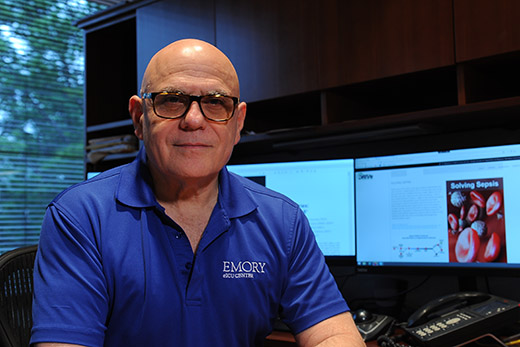The number of elderly Americans hospitalized for sepsis has surged in recent years, placing a significant financial strain on the nation’s health care providers, according to a new federal study led by an Emory University critical care specialist Timothy Buchman, MD, PhD, FCCM.
The study is the first to analyze large amounts of Medicare data related to sepsis, a life-threatening condition caused by the body’s extreme response to an infection.
The analysis revealed a 40 percent increase in the rate of Medicare beneficiaries hospitalized with sepsis over the past seven years That increase was faster than the overall growth in the Medicare population, and the associated costs totaled more than $41 billion in 2018. Although both short and long-term mortality remained high, they declined slightly during the study.
The research team was led by Emory critical care specialist Tim Buchman, who has been working with federal officials to assess the impact of sepsis, one of the largest costs to hospitals and medical centers. Buchman says that the general public may be familiar with sepsis as something that a patient who is already in the hospital may contract, but that is not the team’s primary finding.
“The huge rise in admissions came from patients who had sepsis when they arrived at the hospital,” says Buchman.
It’s an example of what happened to Buchman while working on the study. In February 2019, while at a conference in California, he became ill with an infection that led to his left leg turning red and swelling to twice its normal size.
Prompt treatment with broad spectrum antibiotics and intravenous fluids helped Buchman recover, but it reminded him that “no matter who we are, where we are, and what we do, we are all vulnerable to sepsis.”
Buchman is editor-in-chief of Critical Care Medicine and the federal study’s results were published on February 14 in three papers in that journal:
- Sepsis Among Medicare Beneficiaries: 1. The Burdens of Sepsis, 2012–2018
- Sepsis Among Medicare Beneficiaries: 2. The Trajectories of Sepsis, 2012–2018
- Sepsis Among Medicare Beneficiaries: 3. The Methods, Models, and Forecasts of Sepsis, 2012–2018
The federal study was notable for both its scope -- it was the largest sepsis study based on contemporary Medicare data ever published – and because it was conducted by an agency concerned with biomedical threats such as emerging diseases and bioterrorism: BARDA, the Biomedical Advanced Research and Development Authority.
“We were astonished by the study’s results,” said Rick Bright, PhD, deputy assistant secretary for preparedness and response in the Department of Health and Human Services and director of BARDA. “To save lives in public health emergencies, we must solve sepsis. The findings of this study have implications not only for patient care, particularly after patients are discharged, but also for investments by industry, non-government organizations and government agencies.”
The team’s analysis documents high mortality for patients hospitalized with sepsis. Ten percent of patients with non-severe forms of sepsis died while in the hospital or within a week of discharge, and 60 percent with non-severe forms of sepsis died within three years.
Outcomes were worse among patients with the most severe form of sepsis known as septic shock. Forty percent of these patients died while in the hospital or within a week of being discharged, and 75 percent died within three years. The risk was greater for patients who had other chronic health conditions.
The study did not pinpoint large differences in previous medical history between people who were hospitalized for sepsis and patients who were hospitalized for other reasons. However, diagnoses such as pressure sores, time in a skilled nursing facility or use of other nursing services did predict higher sepsis risk – an opportunity for future intervention.
“Sepsis diagnoses in Medicare beneficiaries thus may be a marker of deeper physiologic fragility as much as it is an acute diagnosis,” the authors conclude.
Over the last decade, federal officials have been paying more attention to sepsis, introducing new quality measures, detection tools and taking steps to facilitate antibiotic development. More information about the federal study is available .
Research team members included the HHS Office of the Assistant Secretary for Preparedness and Response (ASPR), the Centers for Medicare & Medicaid Services (CMS), and collaborators from Acumen LLC of Burlingame, California.

